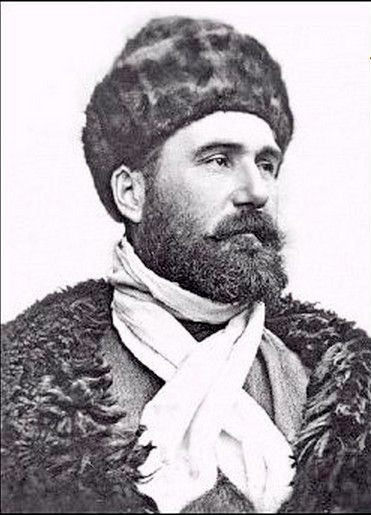The Doukhobor movement arose in the 18th century when many Russian Christians banded together to further their particular Christian beliefs. The Doukhobors rejected the literal teachings of the Bible and, as well, the need for an organized church, instead looking inside themselves for the guidance they sought. The Russian Orthodox Church and the Czarist authorities considered this a threat to the authority of the church, and so began to persecute the Doukhobors. This persecution peaked in the late nineteenth century when they adopted pacifism and renounced militarism.
Tsar Nicholas II, the reigning Tsar at the time, had many Doukhobors exiled to Siberia and the Caucasus, most notably their then leader,
Peter Verigin. Those who refused military service were imprisoned while others suffered beatings or imprisonment for their beliefs.

|
| |
Peter Vasilevich Verigin
|
|
Their plight came to the attention of a few notable Russian citizens, in particular
Leo Tolstoy, as well as Quakers sympathetic to their situation. Together, these groups helped the Doukhobors in emigrating to Canada, a country then attempting to attract immigrants to settle newly opened prairie lands. It was there that the Doukhobors first settled in Saskatchewan, building communal farms and villages.
In Canada, in spite of eventual troubles with the Canadian government, the Doukhobors prospered, building many "agro-industrial" settlements, first in Saskatchewan, then later in Alberta and British Columbia. They created the largest communal undertaking ever achieved in North America.
Verigin was killed, aged 65, in a still-unsolved Canadian Pacific Railway train explosion on October 29, 1924 on the Kettle Valley Railway (now known locally as the Columbia and Western Railway) line near Farron, between Castlegar and Grand Forks, which also killed his 17 year-old female companion Marie Strelaeff, member of the provincial legislature John McKie, P.J Campbell, Hakim Singh, Harry J. Bishop, W. J. Armstrong, and Neil E. Armstrong. The government initially (during investigation) had stated the crime was perpetrated by people within the Doukhobor community, while the Doukhobors suspected Canadian government involvement. To date, it is still unknown who was responsible for the bombing.
From Wikipedia
Peter's body was returned to Brilliant, BC and interred on a hillside near his home. The funeral and burial was attended by over 7,000 individuals, the largest ever held in southern BC. A marble monument was erected over his grave and a massive overhanging rock face above it was engraved with the eulogy of Peter Vasilevitch Verigin.
Now renamed
Verigin Memorial Park, the grounds comprise two acres of old-fashioned gardens enclosed by a wire fence. Stones outline the initials of the leaders, the flower beds and a gazebo. A small building houses a visitor's centre. During the summer months, Doukhobor tour guides are on hand. A well-tended rose garden surrounds the tomb, which was originally an elaborate marble edifice with intricate carvings, but was replaced in 1931 with a plain concrete structure.
To our knowledge there is no sign for the park, except for signage on the highway directing motorists to the park.
Peter Vasilevich Verigin has since been declared a National Historic Person by the Government of Canada. A Parks Canada plaque in his honour, written in three languages, English, French and Russian, was unveiled at the Doukhobor Discovery Centre, a museum of Doukhobor history, in Castlegar in 2012.
Text from Verigin's
Parks Canada Plaque follows.
Known as "Lordly" by his followers, Peter Verigin developed a theory of Christian communalism consistent with core Doukhobor teachings and practices, that played a key role in the community's history. In Russia, he formed what would become the Christian Community of Universal Brotherhood and, with the support of Leo Tolstoy, orchestrated Doukhobor immigration to Canada in 1898-1899. He built communal villages on the Prairies and later, organized the mass migration of his followers to British Columbia. Verigin worked for both their economic and spiritual success until his violent and unsolved death in 1924.
![]()